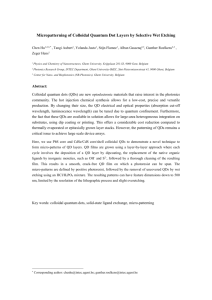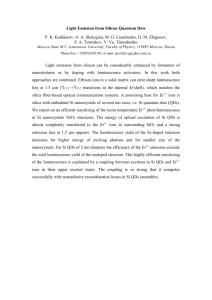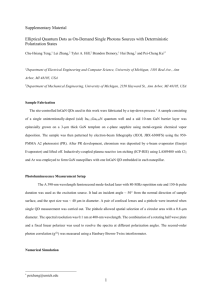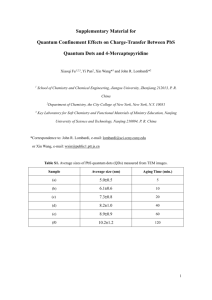1 Emily A. Weiss, Asst. Professor of Chemistry, Northwestern
advertisement
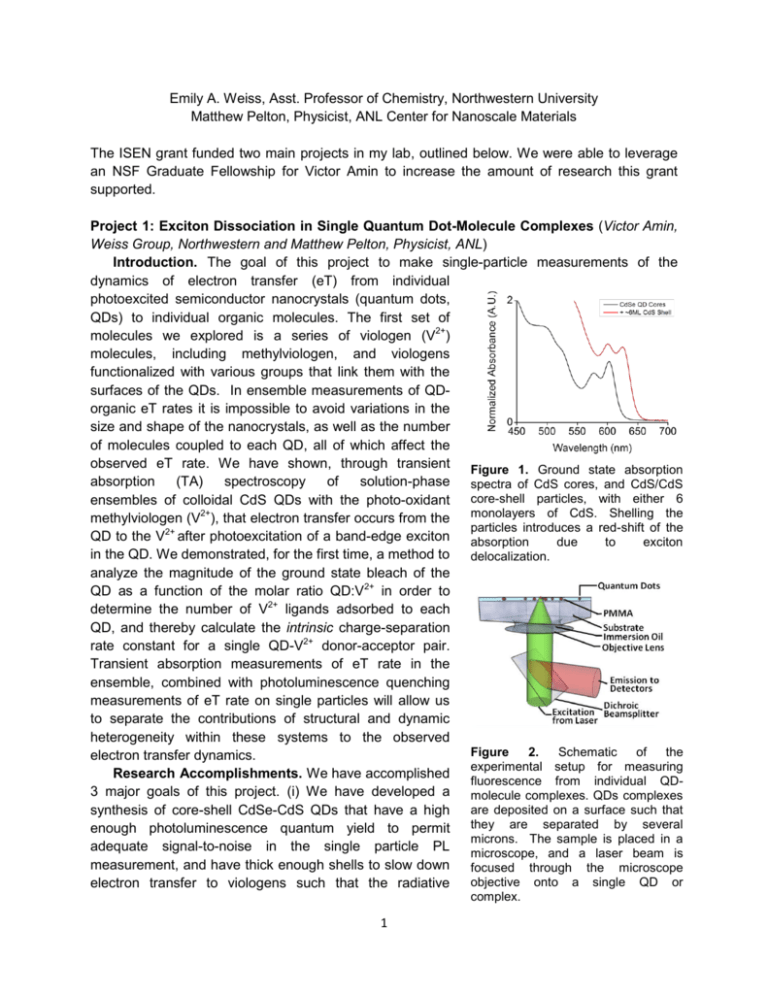
Emily A. Weiss, Asst. Professor of Chemistry, Northwestern University Matthew Pelton, Physicist, ANL Center for Nanoscale Materials The ISEN grant funded two main projects in my lab, outlined below. We were able to leverage an NSF Graduate Fellowship for Victor Amin to increase the amount of research this grant supported. Project 1: Exciton Dissociation in Single Quantum Dot-Molecule Complexes (Victor Amin, Weiss Group, Northwestern and Matthew Pelton, Physicist, ANL) Introduction. The goal of this project to make single-particle measurements of the dynamics of electron transfer (eT) from individual photoexcited semiconductor nanocrystals (quantum dots, QDs) to individual organic molecules. The first set of molecules we explored is a series of viologen (V2+) molecules, including methylviologen, and viologens functionalized with various groups that link them with the surfaces of the QDs. In ensemble measurements of QDorganic eT rates it is impossible to avoid variations in the size and shape of the nanocrystals, as well as the number of molecules coupled to each QD, all of which affect the observed eT rate. We have shown, through transient Figure 1. Ground state absorption absorption (TA) spectroscopy of solution-phase spectra of CdS cores, and CdS/CdS ensembles of colloidal CdS QDs with the photo-oxidant core-shell particles, with either 6 methylviologen (V2+), that electron transfer occurs from the monolayers of CdS. Shelling the particles introduces a red-shift of the QD to the V2+ after photoexcitation of a band-edge exciton absorption due to exciton in the QD. We demonstrated, for the first time, a method to delocalization. analyze the magnitude of the ground state bleach of the QD as a function of the molar ratio QD:V2+ in order to determine the number of V2+ ligands adsorbed to each QD, and thereby calculate the intrinsic charge-separation rate constant for a single QD-V2+ donor-acceptor pair. Transient absorption measurements of eT rate in the ensemble, combined with photoluminescence quenching measurements of eT rate on single particles will allow us to separate the contributions of structural and dynamic heterogeneity within these systems to the observed Figure 2. Schematic of the electron transfer dynamics. experimental setup for measuring Research Accomplishments. We have accomplished fluorescence from individual QD3 major goals of this project. (i) We have developed a molecule complexes. QDs complexes synthesis of core-shell CdSe-CdS QDs that have a high are deposited on a surface such that enough photoluminescence quantum yield to permit they are separated by several microns. The sample is placed in a adequate signal-to-noise in the single particle PL microscope, and a laser beam is measurement, and have thick enough shells to slow down focused through the microscope objective onto a single QD or electron transfer to viologens such that the radiative complex. 1 pathway is competitive. We found the optimal thickness of the shell to be 6 monolayers of CdS (approximately 2 nm). Figure 1 show the absorption spectra for the CdSe cores, and for CdSe/CdS core/shell QDs with 6 monolayers of shell. (ii) In collaboration with Dr. Pelton, we have optimized preparation and deposition parameters for the single-particle experiment for these QDs, and have monitored the fluorescence of single particles with a confocal microscope, see experimental setup in Figure 2. (iii) We have shown that we can control the blinking trajectories of the QDs using the charge-transfer quencher, methylviologen. Figure 3 shows two representative blinking trajectories, one for QDs not treated with methylviologen, and one for QDs treated with methylviologen. The major conclusion from this study is that the lifetime of the 2+ Figure 3. Representative blinking trajectories of single CdSe/CdS QDs without added MV (left) and 2+ with added MV (right), and kinetic traces averaged over time points within selected portions of the blinking trajectory (the colors of the kinetic traces correspond to the shading in the trajectories). In portions of the trajectories where the QDs are “off” (gray shading, black kinetics traces), the PL of QDs 2+ with added MV decays with a time constant indistinguishable from that for bare QDs in their “off” state; 2+ this result indicates that the charge-separated state within QD-MV complexes lives through multiple 2+ excitation events during the experiment, and that MV acts like a surface-electron trap in determining 2+ blinking dynamics. In the “on” states of QD-MV complexes (blue shading, blue kinetic traces), the time constant for PL decay probably corresponds to a time constant for charge separation (electron transfer 2+ for MV ). charge-separated state of the QD-viologen complex is long enough such that the “off states” of QD-viologen complexes look like the “off states” of bare QDs – PL quenched by Auger. When we excite QD-viologen complexes that are not in the charge-separated state, the time constant for decay of the PL is that of charge separation. We are continuing this collaboration with Dr. Pelton. 2 Project 2: The Temperature Dependence of the Intermolecular Structure of Oleate Adlayers on PbS Quantum Dots Probed by Interfacial Electron Transfer to Benzoquinone (Ken Aruda, Weiss Group Northwestern) Introduction. In this project, we explore the enhancement of the bimolecular rate constant for diffusionally gated electron transfer from oleate-capped PbS quantum dots (QDs) to benzoquinone (BQ) in toluene with increasing temperature due to both i) an increased frequency of QD-BQ collisions, and ii) an increased fraction of BQ-QD collisions that result in electron transfer, Figure 4. The increased efficiency of collisionally gated electron transfer (factor ii) is due to increased permeability of the oleate adlayer of the QDs to BQ such that, upon encountering the oleate-coated QD, BQ more frequently achieves a donor-acceptor distance and geometry that permits electron transfer within the lifetime of the encounter complex. One-dimensional quantitative 1H NMR and diffusion-ordered nuclear magnetic resonance spectroscopy (DOSY NMR) show that, with increasing temperature from 0 C to 50 C, the surface coverage of bound oleate molecules on the PbS QDs does not change, but the hydrodynamic radius of the oleate-capped PbS QDs decreases. Coarse-grained molecular dynamics simulations of the soft ligand shell of the QD show that one mechanism for this apparent decrease with increasing temperature is disordering of the oleate monolayer such that a greater volume fraction of the annular space around the inorganic core of the QD includes solvent. As the ligand layer becomes more solvent-like, the drag coefficient (and the measured hydrodynamic radius) of the QDs decreases, and the adlayer becomes more permeable to small molecules, here BQ. We have found that optical studies of both photoinduced and spontaneous charge transfer Figure 4. A) The TA spectrum of 1 µM PbS QDs (black) and 1 µM PbS QDs with 10 µM of BQ (red) (CT) between colloidal QDs and molecular at 0.1 µs after excitation at 950 nm. B) Kinetic redox probes, during which the QDs are stable traces extracted at 1000 nm from the TA spectrum to flocculation and show reproducible behavior in (A) of PbS QDs (black) and PbS QDs with 10 µM over hours or days under illumination, are of BQ (colored) from 0 C to 50 C. The rate of diffusion-controlled quenching of the PbS QDs by useful for defining the pathways by which BQ increases with increasing temperature, while molecules permeate the ligand shell of the the exciton recombination dynamics of the QDs particle. We have also shown that the ability of without added BQ is constant with temperature. C) a molecular redox partner to adsorb to the The fractional yield of collisional electron transfer, , increases as temperature increases. 3 inorganic surface of a QD, where it can participate in photoinduced CT, depends on the density and permeability, rather than the thickness, of the native ligand shell, and that these properties are sensitive to the absolute concentration of the QDs and the binding headgroup of the native ligands. By varying the temperature over a small range for a single sample we can maintain a consistent surface chemistry on the QD, which would be difficult to achieve or quantify for a series of QD samples. This work shows that the intermolecular interactions among alkyl ligands determine the permeability of the organic adlayer to small molecular redox probes, and thereby control the redox activity of the QD. To determine the mechanism by which the collisional quenching efficiency of the QD-BQ system increases with temperature, we determined the diffusion coefficient of the QDs as a function of temperature by measuring the diffusion coefficient of oleate bound to the surface of the QDs, using DOSY 1H NMR. If we consider the QDs to be hard spheres (which they are not due to their soft ligand shells), this set of diffusion coefficients correspond to a range of hydrodynamic radii for the particles of 3.5 nm at 0 C to 2.5 nm at 50 C, where we have included in this calculation the known temperature dependence of the viscosity of the solvent. The apparent radius of the oleate-capped QD therefore decreases with increasing temperature. It is apparent from the temperature dependence of the hydrodynamic radius of the QD that the intermolecular structure of the oleate adlayer changes with temperature. To confirm that this temperature dependence is due to conformational motion of the oleate ligands, we performed a near-complete ligand exchange of the oleate for the shorter, more rigid methylthiophenolate on the surface of the QDs. Figure 5 shows that, unlike the oleate-capped QDs, the hydrodynamic radius of PbS QDs capped primarily with methylthiophenolate is temperature independent over this range. Molecular dynamics simulations indicate that this apparent change in hydrodynamic radius is due to increased permeation of the toluene solvent into the ligand shell with increasing temperature. We believe that the increased permeability of the oleate adlayer to Figure 5. The hydrodynamic radius of 10 µM PbS QDs as a function of temperature solvent translates into an increased permeability to BQ, with an oleate adlayer (black) and and therefore a higher collisional quenching efficiency. methylthiophenol (red). Collaboration with ANL and External Proposals Resulting from ISEN-Funded Research. This project has fostered a productive and continuing collaboration with Dr. Matthew Pelton, who has recently moved from ANL to accept a faculty position at the University of Maryland, Baltimore County. We have already arranged to send him QD samples for further single-particle measurements on QD-molecule complexes. During his time at ANL, he trained my graduate student, Victor Amin, to perform single-particle measurements, and Victor is now the primary user of the microscope apparatus (in Figure 2, above) at ANL. This collaboration has therefore broadened the technical expertise of both of our groups. Additionally, I have just been funded by the NSF to pursue a 3-yr project on electron transfer between QDs and molecules, in which I used some of the data from ISEN-funded work as preliminary results (Award #: CHE-1400596). 4

